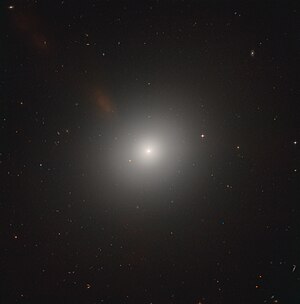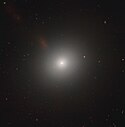Messier 105
| Galaxie Messier 105 | |
|---|---|
(c) ESA/Hubble, CC BY 4.0 | |
| Aufnahme des Hubble-Weltraumteleskops von der elliptischen Galaxie Messier 105 | |
| AladinLite | |
| Sternbild | Löwe |
| Position Äquinoktium: J2000.0, Epoche: J2000.0 | |
| Rektaszension | 10h 47m 49,6s[1] |
| Deklination | +12° 34′ 54″[1] |
| Erscheinungsbild | |
| Morphologischer Typ | E1 / LINER[1] |
| Helligkeit (visuell) | 9,5 mag[2] |
| Helligkeit (B-Band) | 10,5 mag[2] |
| Winkelausdehnung | 5,3′ × 4,8′[2] |
| Positionswinkel | 71°[2] |
| Flächenhelligkeit | 13,1 mag/arcmin²[2] |
| Physikalische Daten | |
| Zugehörigkeit | Leo-I-Gruppe LGG 217[1][3] |
| Rotverschiebung | 0,003039 ± 0,000008[1] |
| Radialgeschwindigkeit | (911 ± 2) km/s[1] |
| Hubbledistanz vrad / H0 | (37 ± 3) · 106 Lj (11,2 ± 0,8) Mpc [1] |
| Geschichte | |
| Entdeckung | Pierre Méchain |
| Entdeckungsdatum | 24. März 1781 |
| Katalogbezeichnungen | |
| M 105 • NGC 3379 • UGC 5902 • PGC 32256 • CGCG 066-018 • MCG +02-28-011 • 2MASX J10474959+1234538 • GC 2203 • H I 17 • h 757 • | |
Messier 105 (auch als NGC 3379 bezeichnet) ist eine 9,5 mag helle elliptische Galaxie mit einer Flächenausdehnung von 5,3′ × 4,8′ im Sternbild Löwe auf der Ekliptik. Die Galaxie ist etwa 37 Millionen Lichtjahre vom Sonnensystem entfernt und gehört zur M96-Gruppe.
Hochauflösende Aufnahmen des Hubble-Weltraumteleskops zeigen eine ringförmige Struktur um das zentrale Schwarze Loch, die sich in rascher Rotation befindet. Nach Berechnungen beträgt die Masse des Schwarzen Lochs etwa 200 Millionen Sonnenmassen, die Galaxie an sich besitzt eine Gesamtmasse von 100 Milliarden Sonnenmassen.[4]
Die in unmittelbarer Nähe befindliche elliptische bzw. linsenförmige Galaxie NGC 3384 (= NGC 3371) ist ein physischer Begleiter von M105. Hingegen ist die sieben Bogenminuten südöstlich von M105 gelegene Spiralgalaxie NGC 3389 (=NGC 3373) weit im Hintergrund.[5][6]
M105 wurde am 24. März 1781 vom französischen Astronomen Pierre Méchain entdeckt. Sie wurde erst nachträglich in den Messier-Katalog aufgenommen.[7]
Weblinks
- Spektrum.de: Amateuraufnahmen [1]
- The heart of the Lion
- Spektrum.de: Umgebungskarte
- M105 bei SEDS
Einzelnachweise
Auf dieser Seite verwendete Medien
Bildtafel der 110 Messier-Objekte. Diese Datei wird in der w:de:Template:Navigationsleiste Messierobjekte als Imagemap genutzt. Sie darf daher nicht durch eine andere Version überschrieben werden!
(c) ESA/Hubble, CC BY 4.0
The heart of the Lion
It might appear featureless and unexciting at first glance, but NASA/ESA Hubble Space Telescope observations of this elliptical galaxy — known as Messier 105 — show that the stars near the galaxy’s centre are moving very rapidly. Astronomers have concluded that these stars are zooming around a supermassive black hole with an estimated mass of 200 million Suns! This black hole releases huge amounts of energy as it consumes matter falling into it and causing the centre to shine far brighter than its surroundings. This system is known as an active galactic nucleus.
Hubble also surprised astronomers by revealing a few young stars and clusters in Messer 105, which was thought to be a “dead” galaxy incapable of star formation. Messier 105 is now thought to form roughly one Sun-like star every 10 000 years. Star-forming activity has also been spotted in a vast ring of hydrogen gas encircling both Messier 105 and its closest neighbour, the lenticular galaxy NGC 3384.
Messier 105 was discovered in 1781, lies about 30 million light-years away in the constellation of Leo (The Lion), and is the brightest elliptical galaxy within the Leo I galaxy group.
Credit:
ESA/Hubble & NASA, C. Sarazin et al.
Coordinates Position (RA): 10 47 49.63 Position (Dec): 12° 34' 55.76" Field of view: 6.31 x 6.39 arcminutes Orientation: North is 127.8° right of vertical
Colours & filters Band Wavelength Telescope Optical g 475 nm Hubble Space Telescope ACS Optical z 850 nm Hubble Space Telescope ACS Optical g 475 nm Hubble Space Telescope ACS Optical Z 850 nm Hubble Space Telescope ACS.
Autor/Urheber: Copyright © 2003 Torsten Bronger., Lizenz: CC BY-SA 3.0
This is a celestial map of the constellation Leo, the Lion.
Hubble peered into the core of Messier 105 (also known as NGC 3379) and measured the motions of stars swirling around its center. These observations proved that a supermassive black hole resides at the galaxy’s heart. According to recent estimates, this black hole could be up to 200 million times as massive as our Sun.









